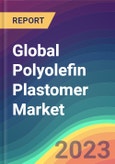The global Polyolefin Plastomer (POP) market has reached approximately 700 thousand tonnes in 2021 and is expected to grow at a CAGR of 4.13% during the forecast period until 2035. The owners of Sabic SK Nexlene Co. (SNNC) recently announced to increase the capacity of polyolefin elastomers and plastomers which will begin to operate in the 2nd quarter of 2024.The Global Polyolefin Plastomer (Pop) Market Has Reached Approximately 700 Thousand Tonnes in 2021 and is Expected to Grow at a CAGR of 4.13% During the Forecast Period Until 2035
Polyolefin Plastomer (POP) is a copolymer of ethylene and octene, synthesized in presence of a metallocene catalyst. This plastomer is stretchy, imperforate-resistant, possess low seal initiation temperature (SIT), high coefficient of friction, non-slip, and is highly stable at low temperatures. POP can be employed alone to create molded or extruded parts or mixed with other plastics such as to improve flexibility of polypropylene or polyethylene-based composites and create flexible packaging. Other applications include automobile accessories, foams, footwear, consumer goods, wire, cable, and packing purposes.
The primary driver of Polyolefin Plastomer (POP) global market is food packaging, which is anticipated to rise in response to rising demand due to growing population and dependence of the population on read-to eat meals and snacks in the forecast period. In 2021, approximately 50% of global Polyolefin Plastomer (POP) was utilized by the Food Packaging Industry. Customer traction is further increased by the growing general need for polyolefin elastomers. POP is widely used for closures, sealing, bottle wads, wrappers, multipurpose pockets, and customized pouches for packing meat and beverages. The demand for packaged food is expected to rise during the forecast period as a result of growth in population. Significant advancements in the food and beverage sector are predicted to enhance the global market for Polyolefin Plastomers. Furthermore, POP can be added to other plastics to improve their flexibility. The global POP market is expected to become a USD 6 billion market by 2035.
Based on demand, the Asia Pacific is dominating the Polyolefin Plastomer (POP) market with a demand of approximately 34% of the global Polyolefin Plastomer (POP). It is expected that Asia Pacific will experience a surge in POP demand as an effect of industrial growth and constructional activities. North America and Europe are also prominent consumers of POP. The automotive, civil industries, building & construction, are the key industries in these regions. During the projected period, these industries are anticipated to rise steadily in North America and Europe. Based on production, approximately 30% of the global POP took place in Spain, with Dow Chemical Company as the leading producer.
Based on the end-user industry, the global Polyolefin Plastomer (POP) market is segmented into different industrial sectors that include Food Packaging, Industrial Packaging, Hot Melt Adhesives (HMA), and others. The Food Packaging industry is the dominating as a consumer industry for Polyolefin Plastomer (POP) market. Industrial Packaging and Hot Melt Adhesives (HMA) are also significant consumers of the POP market. Furthermore, POP-based Hot Melt Adhesives are more stable and cheaper than EVA-based Hot Melt Adhesives, which further contributes towards its application the construction sector, fueling the POP demand on a global level.
Major players in the production of Global Polyolefin Plastomer (POP) are Dow Chemical Company, ExxonMobil Chemical Company, SCG-Dow Group, SABIC SK Nexlene Company (SSNC), LG Chem, and Borealis Borouge.
Years considered for this report:
- Historical Period: 2015- 2021
- Base Year: 2021
- Estimated Year: 2022
- Forecast Period: 2023-2035
Objective of the Study:
- To assess the demand-supply scenario of Polyolefin Plastomer (POP) which covers production, demand and supply of Polyolefin Plastomer (POP) market in the globe.
- To analyse and forecast the market size of Polyolefin Plastomer (POP)
- To classify and forecast Global Polyolefin Plastomer (POP) market based on end-use and regional distribution.
- To examine competitive developments such as expansions, mergers & acquisitions, etc., of Polyolefin Plastomer (POP) market in the globe.
The publisher calculated Polyolefin Plastomer (POP) demand in the globe by analyzing the historical data and demand forecast which was carried out considering the historical extraction and supply and demand of Polyolefin Plastomer (POP) across the globe. The publisher sourced these values from industry experts, and company representatives and externally validated through analyzing historical sales data of respective manufacturers to arrive at the overall market size. Various secondary sources such as company websites, association reports, annual reports, etc., were also studied by the publisher.
Key Target Audience:
- Polyolefin Plastomer (POP) manufacturers and other stakeholders
- Organizations, forums and alliances related to Polyolefin Plastomer (POP) distribution
- Government bodies such as regulating authorities and policy makers
- Market research organizations and consulting companies
Report Scope:
In this report, Global Polyolefin Plastomer (POP) s market has been segmented into following categories, in addition to the industry trends which have also been detailed below:- Market, by End-Use: Food Packaging, Industrial Packaging, Hot Melt Adhesives (HMA), and others.
- Market, by Sales Channel: Direct Sale and Indirect Sale
- Market, by Region: North America, Europe, Asia Pacific, Middle East and Africa, and South America.








